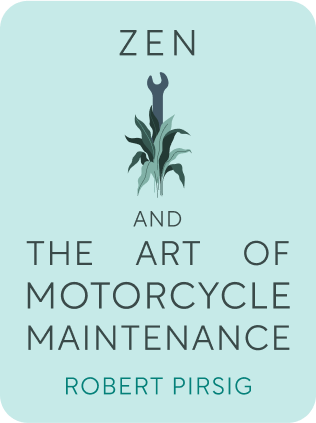

This article is an excerpt from the Shortform book guide to "Zen And The Art Of Motorcycle Maintenance" by Robert Pirsig. Shortform has the world's best summaries and analyses of books you should be reading.
Like this article? Sign up for a free trial here .
What is the quality of life meaning? How does Robert Pirsig explain quality?
In Zen and the Art of Motorcycle Maintenance, Robert Pirsig gives the idea of quality of life meaning in a few key ways. He also highlights the importance of striving for quality of life.
Read more about the quality of life meaning according to Zen and the Art of Motorcycle Maintenance.
Cultivating Quality of Life: Meaning and More
The hikers have stopped at a water source and are eating lunch. They’re descending the ridge along a different trail, into a different canyon. Although Chris is disappointed that they won’t be summiting the mountain, he offers to carry some of the heavy stuff Pirsig transferred to his pack.
Back on the trail, the going is relatively rough—the slope is steep, and Pirsig has to hack through the overgrown brush with his machete—but eventually the hikers make it to a road. Some fellow campers give them a ride back into Bozeman; it’s late by the time they arrive, and Pirsig decides to check them into a hotel rather than wake the DeWeeses. They’re asleep almost as soon as they lie down.
In the morning, Pirsig and Chris return to the DeWeeses’ to say their goodbyes, then they’re back on Pirsig’s cycle, heading West.
Chautauqua: Coming Down the Mountain
Pirsig wants to effect a change in emphasis, from the abstract to the practical. His final judgment is mixed on whether Phaedrus advanced human knowledge either of the Tao or Quality, but what he did achieve was an expansion of our notion of reason. Although he was a dyed-in-the-wool classical thinker, Phaedrus used the tools of rational argument to reach beyond what we typically consider rational or logical. First he needed to know the quality of life meaning.
The first step down from Phaedrus’s abstraction to Pirsig’s practical use is to recognize that if Quality is indeed the Buddha (or the Tao)—the entity from which all other entities spring—then it unites three key areas of human experience: Art, Religion, and Science.
Quality’s relation to Science is Pirsig’s primary concern, and he begins his discussion with the 19th-century French scientist and philosopher Jules Henri Poincaré—who, in his scientific researches, reached the same impasse that Phaedrus did.
Poincaré was active during a time of crisis in the physical sciences, one wrought by the appearance of the Theory of Relativity, which undermined the laws of physics as they’d been understood for years. The seeds for this crisis, as Poincaré showed in his book Foundations of Science, were actually sewn decades earlier, when mathematicians were able to propose internally consistent geometries that were incompatible both with Euclidean geometry (the standard) and each other. What this meant was that a canny mathematician could create geometries that were equally as accurate and logically sound as the one taken for granted as “true.”
The riders coast through a series of towns—Butte, Anaconda, Phillipsburg—and eventually stop at church to take a rest. Pirsig notes how lonely it is on the road without the Sutherlands. He returns to the Chautauqua to occupy his mind.
Chautauqua: Poincaré’s Truth and More on the Quality of Life Meaning
Poincaré’s analysis of non-Euclidean geometries yielded this insight: that a given geometry was simply a set of conventions that was either more or less convenient for a given task; that is, no particular geometry was true but rather advantageous.
This observation led Poincaré to critique further foundational scientific concepts, space and time in particular. He found again that there is no “true” measure for space or time, only more or less useful conventions created by human beings.
The usefulness of a given convention is decided by the “facts”—observable objects and phenomena. But what Poincaré realized is that there are simply too many facts to choose from. For example, if one wants to study human life, where does one start? With the “fact” of human consciousness? The “fact” of the nervous system? The “fact” of DNA?
Poincaré sketched how a typical scientist chooses facts to concentrate on. The most important trait of a fact was its generality. If the study of a particular fact would yield knowledge of an array of related facts, then that was a better fact to explore than one that would only yield knowledge of itself.
But how can one know, before one begins experimenting, which facts are general and which are specific? Poincaré examined his own mathematical process and found that his breakthroughs came to him suddenly and inexplicably, as if out of thin air. His conclusion was that a “subliminal self” selects the proper facts based on their “beauty” and “harmony” with preexisting facts—in short, that facts are selected by an aesthetic sense rather than a strictly scientific one.
(Shortform note: In his exposition of Poincaré, Pirsig at times conflates two distinct senses of the word “fact.” Sometimes he uses “fact” to mean “observable phenomena”; other times, he uses it to denote a “true statement” or “rule.”)
Poincaré’s ideas, like Phaedrus’s, met with stout resistance. He, like Phaedrus, was accused of touting a radical subjectivism, a theory that turned scientific facts into “just what you like.” Poincaré didn’t refute this possibility. But what he didn’t consider was the existence of a third entity that preceded the encounter of the scientist with the fact and that drew the scientist to the fact: Quality. But what’s the quality of life meaning?
When Pirsig discovered the writings of Poincaré, he became emotional, because it was clear that Phaedrus and Poincaré were struggling with the same troubling questions and coming up with similar answers. (Poincaré’s “subliminal self” corresponded with Phaedrus’s “preconscious awareness,” and the “harmony” of Poincaré’s system resembled Quality.) Phaedrus, however, went one step further than Poincaré. He proposed an all-encompassing force that organized scientists’ choices. Scientists weren’t selecting facts willy-nilly; they were being guided by a sense of Quality.
After gassing up in Missoula, Pirsig and Chris ride out of town to the southwest. Pirsig recalls that the road they’re on, when Phaedrus lived in Montana, was unpaved and squiggly; now it’s paved and features wide turns. The two stop for lunch at Lolo Pass, then ride up into the mountains on a logging road to find a place to camp.
They find an abandoned side road with a felled tree and decide to pitch camp there. The surroundings are awe-inspiring, and Chris goes off exploring by himself. When he returns, he reveals to Pirsig that he’s accidentally soiled himself. The two wash Chris’s underwear in a stream, and on the way back to camp, Chris asks Pirsig what he should be when he grows up. Pirsig answers, “Honest.”
That night, Pirsig has his recurring dream with the glass door, only he realizes he isn’t in a room—he’s in a coffin, and his family outside is paying their last respects. He tries to push open the door but a shadowy figure prevents him. Pirsig yells to Chris that he’ll see him some time in the future and the shadowy figure moves closer to Pirsig menacingly. Chris answers “Where?” just before the figure pulls a curtain over the door. Pirsig tells Chris he’ll see him at the bottom of the ocean, but he suddenly finds himself in an abandoned city, alone.
In the morning, Pirsig is awake before Chris. The weather is brisk but clear, and Pirsig does some jogging to warm up. He packs the motorcycle with everything but Chris’s sleeping bag, then gently nudges Chris awake. On the road, the weather is pristine.
The riders stop for breakfast at lodge, and Chris tells Pirsig he wants to write a letter to his mother. He begins, but gets stuck immediately after addressing the letter. Pirsig tells him he’ll help after they finish eating. When they return their attention to the letter, Pirsig tells Chris that he’s stuck because he’s thinking about too many things at once: he’s thinking simultaneously about what to say and what to say first. Pirsig’s solution is to list everything Chris wants to tell his mother, and then later they’ll pick the best ones and decide on an order.
Chautauqua: Stuckness and Its Remedy
Pirsig informs us that he’s been looking forward to this particular Chautauqua for some time, because it returns us to the practical situation Pirsig began with—the maintenance of a motorcycle. He wants to show how a knowledge of Quality can help a rider better care for his cycle.
He begins with a condition universal to scientists, artists, children writing to their mothers, and amateur motorcycle mechanics—stuckness. His example concerns a cyclist attempting to remove a stuck screw from his cycle’s side panel. The cyclist chooses the wrong technique and ends up stripping the screw. Now he’s completely at a loss for how to move forward. The scientific method doesn’t help him, because he doesn’t have any hypotheses to begin with.
Counter-intuitively, Pirsig thinks this is the best place for the mechanic to be, because it forces the mechanic to rely not on predetermined structures of knowledge (classical thinking) but his innate sense of Quality—which can be thought of, in this case, as the value of any given action or entity communicated to us by our “subliminal self” (Poincaré) or “preconscious awareness” (Phaedrus). Perhaps the mechanic decides to research motorcycle-specific tools and discovers a more effective technique for removing the screw. Or maybe he starts thinking about the individual aspects of the screw—its head, its thread—and develops a novel solution based on a new understanding of the screw and the tools at hand.
In short, being attuned to Quality rather than rehearsing traditional patterns of thought allows human beings to think outside the box: it allows us to innovate.
And, says Pirsig, being attuned to Quality is nothing more or less than having a sense of what’s good.
The riders are cruising through Idaho; now that they’re used to being on the cycle for long stretches, they’re able to ride for many miles without taking breaks. Their route takes them from the top of a ridge down thousands of feet into a valley along hairpin turns. Even Chris is excited by the experience.
Chautauqua: The Ugliness of Technology
The Sutherlands and their fellow romantics’ distaste for technology actually has little to do with the technology itself (its materials of manufacture or appearance, for example). Rather, it’s a byproduct of the way modern humans both create and use technology. Neither party identifies with the technology—it appears as an inert object created to be consumed. Pirsig compares modern technologies—plastics, say—with the wall Phaedrus saw in Korea. The wall was a transcendent act of human ingenuity, not unlike flight or walking on the moon. The problem is that triumphs like the wall or walking on the moon overshadow the transcendent examples of technology in our everyday lives.
The key to appreciating those everyday miracles of technology is engaging with technology using both classical and romantic thinking—in fact, engaging with the world using both styles of thinking—for that is when Quality reveals itself. And the best way to activate and unify both the classical and romantic modes of our understanding is to achieve peace of mind in whatever task we’re attempting to accomplish.
As we work, rather than burden our consciousnesses with precise instructions or fear of failure, we must quiet our minds and simply attend to our tasks. When someone says of us, “You look lost in your work,” then we know we’re relating to our work in a profound and personal way. If we’re completely immersed in our fixing a motorcycle, for example, we’ve dissolved the boundary between subject and object—between person and thing—and hooked into the mystical world of Quality.
After many miles, the road finally rises out of the canyon into cool pine forests, but just as quickly the riders return to a desert landscape. The setting sun puts Pirsig in a melancholic mood.
The riders stop for the evening in a town called Cambridge. They pitch camp in a nearby campground. There’s no one there but them. Pirsig tells Chris they’ll be going into Oregon tomorrow, and soon enough Chris is asleep. Lying awake, Pirsig worries about his relationship with Chris: Sometimes he feels close to Chris, other times he feels like Chris is utterly alien to him.
Once he defines the quality of life meaning, Pirsig goes on to explain how you can achieve it.

———End of Preview———
Like what you just read? Read the rest of the world's best book summary and analysis of Robert Pirsig's "Zen And The Art Of Motorcycle Maintenance" at Shortform .
Here's what you'll find in our full Zen And The Art Of Motorcycle Maintenance summary :
- How an unnamed narrator and his son are on a cross-country motorcycle journey
- Why technology can be creative
- How to focus on what's in front of you in order to get exactly what you need






